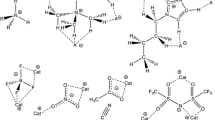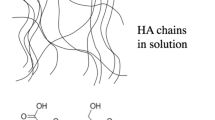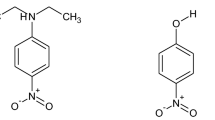Abstract
We have recorded the THz spectra of the peptides NALA and NAGA as well as the amino acid leucine as model systems for hydrophobic and hydrophilic hydration. The spectra were recorded as a function of temperature and concentration and were analyzed in terms of a principal component analysis approach. NAGA shows positive absorptions with an increasing effective absorption coefficient for increasing concentrations. We conclude that NAGA due to its polar and hydrophilic structure does not have a significant influence on the surrounding water network, but is instead integrated into the water network forming a supramolecular complex. In contrast, for NALA, one hydrogen atom is substituted by a hydrophobic iso-butyl chain. We observe for NALA a decrease in absorption below 1.5 THz and a nonlinearity with a turning point around 0.75 M. Our measurements indicate that the first hydration shell of NALA is still intact at 0.75 M (corresponding to 65 water molecules per NALA). However, for larger concentrations the hydration shells can overlap, which explains the nonlinearity. For leucine, the changes in the spectrum occur at smaller concentrations. This might indicate that leucine exhibits a long-range effect on the solvating water network.












Similar content being viewed by others
References
Acbas, G., Niessen, K. A., Snell, E. H. & Markelz, A. G. Optical measurements of long-range protein vibrations. Nat. Commun. 5, 1–7 (2014).
Born, B., Weingärtner, H., Bründermann, E. & Havenith, M. Solvation dynamics of model peptides probed by terahertz spectroscopy. observation of the onset of collective network motions. J. Am. Chem. Soc. 131, 3752–3755 (2009).
Born, B. & Havenith, M. Terahertz dance of proteins and sugars with water. in Journal of Infrared, Millimeter, and Terahertz Waves 30, 1245–1254 (2009).
Heugen, U. et al. Solute-induced retardation of water dynamics probed directly by terahertz spectroscopy. Proc. Natl. Acad. Sci. U. S. A. 103, 12301–6 (2006).
Born, B., Kim, S. J., Ebbinghaus, S., Gruebele, M. & Havenith, M. The terahertz dance of water with the proteins: the effect of protein flexibility on the dynamical hydration shell of ubiquitin. Faraday Discuss. 141, 161–173 (2009).
Xu, Y. & Havenith, M. Perspective: watching low-frequency vibrations of water in biomolecular recognition by THz spectroscopy. J. Chem. Phys. 143, 170901 (2015).
Heyden, M. et al. Long-range influence of carbohydrates on the solvation dynamics of water-answers from terahertz absorption measurements and molecular modeling simulations. J. Am. Chem. Soc. 130, 5773–5779 (2008).
Heyden, M. & Havenith, M. Combining THz spectroscopy and MD simulations to study protein-hydration coupling. Methods 52, 74–83 (2010).
Fogarty, A. C. & Laage, D. Water dynamics in protein hydration shells: the molecular origin of the dynamical perturbation. J. Phys. Chem. B 118, 7715–7729 (2014).
Laage, D., Elsaesser, T. & Hynes, J. T. Perspective: structure and ultrafast dynamics of biomolecular hydration shells. Struct. Dyn. 4, 44018 (2017).
Nibali, V. C. & Havenith, M. New insights into the role of water in biological function: studying solvated biomolecules using terahertz absorption spectroscopy in conjunction with molecular dynamics simulations. J. Am. Chem. Soc. 136, 12800–12807 (2014).
Heyden, M. & Tobias, D. J. Spatial dependence of protein-water collective hydrogen-bond dynamics. Phys. Rev. Lett. 111, 218101 (2013).
Rezus, Y. L. A. & Bakker, H. J. Observation of immobilized water molecules around hydrophobic groups. Phys. Rev. Lett. 99, 148301 (2007).
Funkner, S., Havenith, M. & Schwaab, G. Urea, a structure breaker? Answers from THz absorption spectroscopy. J. Phys. Chem. B 116, 13374–13380 (2012).
Murarka, R. K. & Head-Gordon, T. Dielectric relaxation of aqueous solutions of hydrophilic versus amphiphilic peptides. J. Phys. Chem. B 112, 179–186 (2008).
Head-Gordon, T., Sorenson, J. M., Pertsemlidis, A. & Glaeser, R. M. Differences in hydration structure near hydrophobic and hydrophilic amino acids. Biophys. J. 73, 2106–2115 (1997).
Murarka, R. K. & Head-Gordon, T. Single particle and collective hydration dynamics for hydrophobic and hydrophilic peptides. J. Chem. Phys. 126, 215101 (2007).
Niehues, G., Heyden, M., Schmidt, D. A. & Havenith, M. Exploring hydrophobicity by THz absorption spectroscopy of solvated amino acids. Faraday Discuss. 150, 193–207 (2011).
Comez, L. et al. More is different: experimental results on the effect of biomolecules on the dynamics of hydration water. J. Phys. Chem. Lett. 4, 1188–1192 (2013).
Sasisanker, P. & Weingärtner, H. Hydration dynamics of water near an amphiphilic model peptide at low hydration levels: a dielectric relaxation study. ChemPhysChem 9, 2802–2808 (2008).
Head-Gordon, T. Is water structure around hydrophobic groups clathrate-like? Proc. Natl. Acad. Sci. U. S. A. 92, 8308–8312 (1995).
Russo, D., Murarka, R. K., Copley, J. R. D. & Head-Gordon, T. Molecular view of water dynamics near model peptides. J. Phys. Chem. B 109, 12966–75 (2005).
Pertsemlidis, A., Saxena, A. M., Soper, A. K., Head-Gordon, T. & Glaeser, R. M. Direct evidence for modified solvent structure within the hydration shell of a hydrophobic amino acid. Proc. Natl. Acad. Sci. U. S. A. 93, 10769–10774 (1996).
Gallagher, K. R. & Sharp, K. A. A new angle on heat capacity changes in hydrophobic solvation. J. Am. Chem. Soc. 125, 9853–9860 (2003).
Laage, D. & Hynes, J. T. On the molecular mechanism of water reorientation. J. Phys. Chem. B 112, 14230–14242 (2008).
Laage, D. & Hynes, JT. A molecular jump mechanism of water reorientation. Science (80). 311, 832–835 (2006).
Sharp, K. A., Madan, B., Manas, E. & Vanderkooi, J. M. Water structure changes induced by hydrophobic and polar solutes revealed by simulations and infrared spectroscopy. J. Chem. Phys. 114, 1791–1796 (2001).
Sharp, K. A. Water: structure and properties. in eLS (2001).
Sharma, V., Böhm, F., Schwaab, G. & Havenith, M. The low frequency motions of solvated Mn(II) and Ni(II) ions and their halide complexes. Phys. Chem. Chem. Phys. 16, 25101–25110 (2014).
Wold, S., Esbensen, K. & Geladi, P. Principal component analysis. Chemom. Intell. Lab. Syst. 2, 37–52 (1987).
Abdi, H. & Williams, L. J. Principal component analysis. WIREs Comp Stat 2, 433–459 (2010).
Kessler, W. Multivariate Datenanalyse. (2007).
Decka, D., Schwaab, G. & Havenith, M. A THz/FTIR fingerprint of the solvated proton: evidence for Eigen structure and Zundel dynamics. Phys. Chem. Chem. Phys. 17, 11898–11907 (2015).
Böhm, F., Schwaab, G. & Havenith, M. Mapping hydration water around alcohol chains by THz calorimetry. Angew. Chemie - Int. Ed. 56, 9981–9985 (2017).
Sun, J. et al. Understanding THz spectra of aqueous solutions: glycine in light and heavy water. J. Am. Chem. Soc. 136, 5031–5038 (2014).
Acknowledgments
We thank J. Savolainen for helpful discussions when setting up the THz—time-domain laser system and G. Schwaab for his support when analysing the data.
Funding
This work is part of the Cluster of Excellence Ruhr Explores Solvation (RESOLV) (EXC 1069) funded by the Deutsche Forschungsgemeinschaft.
Author information
Authors and Affiliations
Corresponding author
Rights and permissions
About this article
Cite this article
Wirtz, H., Schäfer, S., Hoberg, C. et al. Differences in Hydration Structure Around Hydrophobic and Hydrophilic Model Peptides Probed by THz Spectroscopy. J Infrared Milli Terahz Waves 39, 816–827 (2018). https://doi.org/10.1007/s10762-018-0478-2
Received:
Accepted:
Published:
Issue Date:
DOI: https://doi.org/10.1007/s10762-018-0478-2




